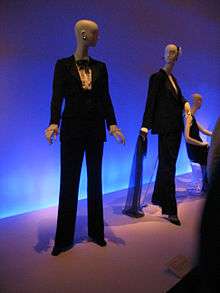Le Smoking
Created in 1966 by famous couturier Yves Saint Laurent,[1] the Le Smoking tuxedo suit for women was the first of its kind to earn attention in the fashion world and in popular culture. The tuxedo suit was designed for women. The collection created huge negative responses at first. The designer took bits and pieces from both men’s suit and women’s clothing and combined it with new ideas. As the tuxedo was designed for females, they were different from the normal male tuxedo. The collar was more feminine as the shape and curve were more subtle. The waistline of the blouse was narrowed to show the body shape and pants were adjusted to help elongate the leg.

It pioneered long, minimalist, androgynous styles for women, as well as the use of power suits and the pantsuit in modern-day society. Fashion photography echoes the influence of this suit in shoots that feature androgynous models with slicked-back hair in a mannish three-piece suit, a style that was first popularised in photographs by Helmut Newton.[1][2] Saint Laurent was seen by many as having empowered women by giving them the option to wear clothes that were normally worn by men with influence and power.[2][3]
This suit has continued to influence fashion designers' collections through the 2000s.[3][4]
In French and many other languages, the pseudo-anglicism smoking is a generic colloquialism referring to any kind of tuxedo/black tie clothing. It is a false friend deriving from the Victorian fashion of the smoking jacket.
References
- Alexander, Hilary. "Smoke Without Fire." The Telegraph (Dec. 12, 2005). Archived February 13, 2010, at the Wayback Machine
- Menkes, Suzy. "A toast to Yves for 'le smoking.'" The International Tribune (Oct. 10, 2005). Archived February 19, 2006, at the Wayback Machine
- "Paris honours the Tuxedo, Yves St. Laurent's fashion favourite." Agence France-Presse (Oct. 3, 2005). Archived December 21, 2005, at the Wayback Machine
- "Le Smoking". Dazed Digital. Archived from the original on February 7, 2009.